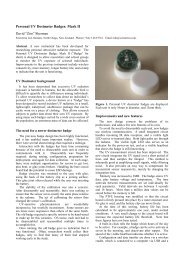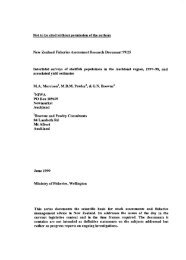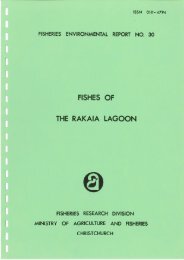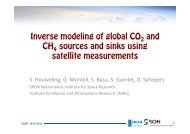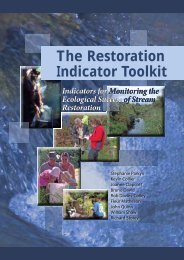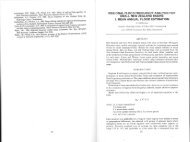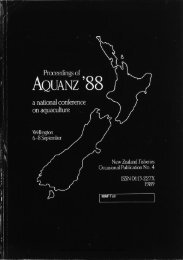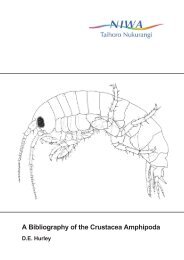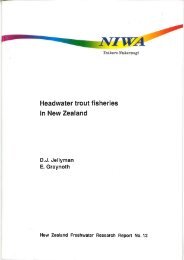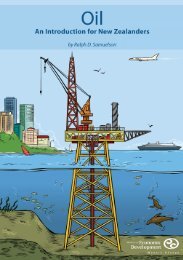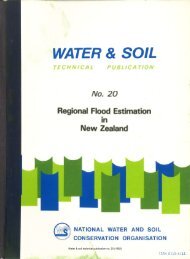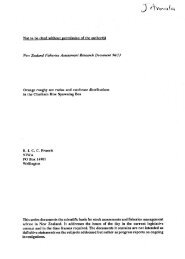Computer Models Define Tide Variability - NIWA
Computer Models Define Tide Variability - NIWA
Computer Models Define Tide Variability - NIWA
You also want an ePaper? Increase the reach of your titles
YUMPU automatically turns print PDFs into web optimized ePapers that Google loves.
FEATURE<br />
<strong>Computer</strong> <strong>Models</strong> <strong>Define</strong><br />
<strong>Tide</strong> <strong>Variability</strong><br />
by Derek Goring<br />
The tide consists of as many as 600 harmonic constituents.<br />
Of these components, however, eight are<br />
primary tides—four diurnal (once daily) and four semidiurnal<br />
(twice daily). Of these eight, just three semidiurnal<br />
tides comprise more than 90% of the tidal energy in<br />
most places. These three tides are the lunar,<br />
solar, and elliptic, the last arising because the<br />
moon’s orbit is elliptical rather than circular.<br />
For most sites, you can forecast the tide to centimeter<br />
accuracy in height and a few minutes<br />
accuracy in time if you know just the eight primary<br />
tide constituents.<br />
We can accurately identify all eight constituents<br />
by installing a tide gauge and recording<br />
hourly data for 206 days, the time span between the<br />
tides of highest range, called perigean spring tides, which<br />
occur when a full or new moon coincides with the<br />
moon’s closest approach to Earth. Once identified for a<br />
particular location, hydrographers can use the eight constituents<br />
to forecast or hindcast the tide at that site for<br />
decades or even centuries. In some places, however, tides<br />
Solving<br />
complex<br />
forecasting<br />
problems<br />
South<br />
Island<br />
D‘Urville<br />
Island<br />
Marlborough<br />
Sounds<br />
Cook<br />
Strait<br />
Figure 1. In this cotidal chart of Cook Strait for the primary lunar<br />
semidiurnal tide (M2 ), colors denote the amplitude and lines denote<br />
the time of high tide in hours after midnight on January 1, 1900.<br />
OCTOBER/NOVEMBER 2001 © American Institute of Physics<br />
Kapiti<br />
Island<br />
North<br />
Island<br />
40 km<br />
14 The Industrial Physicist<br />
along a coast can be quite different just short distances<br />
apart. One such place is Cook Strait, between the North<br />
and South Islands of New Zealand (Figure 1).<br />
Along the southwestern coast of North Island, the<br />
time of high tide varies by 3 h within a few kilometers,<br />
although its amplitude is constant and only about 20<br />
cm. However, along the western side of D’Urville Island<br />
to the north of South Island, the time of high tide is constant<br />
but the amplitude varies by 30 cm. This spatial<br />
variability in the time and height of high tide is important<br />
to the whole range of marine stakeholders, from<br />
fishers to yachtsmen and from marine farmers to hydrographers.<br />
Yet deploying tide gauges every few kilometers<br />
along the coast is impractical for a country such as New<br />
Zealand, which has an 11,000-km coastline but only 3.5<br />
million people.<br />
Applying physics<br />
Using the two most basic laws of physics—conservation<br />
of mass and conservation of momentum (Newton’s<br />
second law)—and a lot of modern technology, we can<br />
now solve the problem of defining the spatial<br />
variability of tides.<br />
Applying these two laws to fluid flow results<br />
in a set of partial differential equations: a continuity<br />
equation and the Navier–Stokes equations.<br />
This complicated set of equations must be simplified<br />
for most practical problems. First, we<br />
eliminate turbulence by averaging to give the<br />
Reynolds-averaged Navier–Stokes equations.<br />
Then we apply a shallow-water assumption—the<br />
simplification that the waves under consideration<br />
are very long compared to the water depth.<br />
Using this simplification, we can eliminate<br />
the vertical dimension by integrating velocities<br />
over depth and by assuming that the pressure<br />
distribution over depth will be hydrostatic. This<br />
results in a two-dimensional, time-varying problem<br />
with three equations—a continuity equation<br />
and two momentum equations—and three<br />
unknowns: water surface displacement (η), and<br />
eastward and northward depth-averaged velocities<br />
(u and v). Because we are solving for tides,<br />
which are harmonic, we can eliminate time by<br />
converting all variables into the frequency<br />
domain using Fourier transformation and solve for each<br />
tide with its unique frequency in turn.<br />
Special care must be taken with the two nonlinear
Figure 2. The area of each<br />
triangular element of the<br />
Cook Strait region is proportional<br />
to the average depth<br />
under it; long waves take<br />
the same time to propagate<br />
across all elements.<br />
Figure 3. In this animation<br />
sequence, velocity vectors<br />
are shown for the Cook<br />
Strait primary M2 tide over<br />
selected time intervals.<br />
terms (convective accelerations and<br />
friction) to properly accommodate the<br />
interactions between harmonic components,<br />
because such interactions<br />
generate harmonics at other frequencies.<br />
In addition, for friction, the total velocity<br />
for all tides must be used, not just the velocity<br />
of the particular tide under consideration.<br />
To accommodate these nonlinear effects, we<br />
must iterate several times through the tides<br />
until the solutions for all tides converge.<br />
Transforming from the time domain to the<br />
frequency domain involves substituting each<br />
time-series variable with its harmonic equivalent.<br />
For example, for the eastward velocity<br />
we use u(t)=Ue i(ωt–φ), where t is time, U is<br />
the amplitude, φ is the phase, ω is the angular<br />
frequency of the tide under consideration,<br />
and i = √–1. This makes all the unknown<br />
variables complex with the form u r + iu i,<br />
where u r = U cos φ is the real part and u i =<br />
U sin φ is the imaginary part.<br />
At one time, we would have had to solve<br />
for real and imaginary parts separately, but<br />
modern computer languages easily handle<br />
complex numbers. The resulting problem<br />
consists of three nonlinear, complex partial<br />
differential equations in Cartesian coordinates.<br />
To accommodate the curvature of the<br />
Earth, however, these coordinates must be<br />
transformed into spherical polar coordinates.<br />
We discretize in space—that is, convert<br />
from continuous variables in partial differential<br />
equations to their numerical, or discrete,<br />
equivalent—by using a finite-element<br />
method. In this approach, we divide the geographical<br />
domain of interest into a series of<br />
triangles called “elements” (Figure 2) and<br />
define the tide amplitude and eastward and<br />
South<br />
Island<br />
northward velocities at each node of each triangle. Then,<br />
for each element we evaluate the discretized differential<br />
equations and assemble them into three global matrix<br />
problems in η, u, and v. We solve these problems separately<br />
and iteratively, first solving the continuity equation<br />
for η using u and v from the previous iteration. Then we<br />
solve the momentum equations for u and v using the<br />
newly calculated values for η. We repeat this process<br />
until the changes in the unknowns become negligible.<br />
Boundary conditions<br />
To drive the model, we need to apply boundary conditions,<br />
which are the values of the unknown variables<br />
applied at the boundary of the model domain. For these<br />
conditions, we use results from the work of researchers<br />
who have analyzed data from the U.S.–French oceanographic<br />
satellite TOPEX/Poseidon. The satellite measures<br />
the water surface displacement of the open ocean well<br />
away from the continents. These data have been converted<br />
into tidal constituents at 1º spacing around the globe<br />
and are available to researchers.<br />
Unfortunately, the satellite gives unreliable results<br />
near land, and so we need a model that uses hydrodynamic<br />
equations. Thus, for each of the tides in turn, we<br />
apply the amplitude and phase (converted to complex<br />
numbers) of the water level displacement from<br />
TOPEX/Poseidon at the nodes around the open-ocean<br />
boundary of the model. The solution gives us the amplitude<br />
and phase for the three variables (η, u, and v) at<br />
each of the 32,000 nodes in the model.<br />
We repeat this process for 13 tidal constituents (8<br />
major tides and 5 minor tides). Then, to accommodate the<br />
nonlinear interactions between constituents and friction,<br />
we solve again for the 13 tides using the previous results<br />
15 The Industrial Physicist<br />
North<br />
Island<br />
40 km
1<br />
2<br />
3<br />
4<br />
5<br />
6<br />
7<br />
8<br />
9<br />
10<br />
11<br />
12<br />
13<br />
14<br />
Figure 4. In this animation sequence, the primary M 2<br />
tide amplitude is shown as it rotates counterclockwise<br />
around both islands of New Zealand (red is<br />
high, blue is low, green is zero elevation).<br />
as starting points. We repeat<br />
this iteration until we get<br />
convergence for all 3 variables<br />
at all 32,000 nodes and<br />
for all 13 tides. With modern<br />
computers and an efficient<br />
matrix solver, this process<br />
takes about 12 h on a 600-<br />
MHz personal computer.<br />
To check the results, we<br />
have installed sea-level<br />
recorders at 11 locations<br />
around the New Zealand<br />
coast (Figure 5a). These<br />
highly accurate digital<br />
recorders measure sea level<br />
every 5 min to millimeter<br />
accuracy. The sea-level<br />
record contains information<br />
not only about tides, but<br />
also about storm surges,<br />
tsunami, and long-term sealevel<br />
changes. The recorders<br />
are linked by cellular telephone<br />
to our office, and we<br />
download the data daily to<br />
perform quality assurance<br />
checks and archive the data.<br />
Unlike many sea-level<br />
recorders worldwide that<br />
have been installed to assist<br />
in navigation, this network<br />
was commissioned for purely<br />
scientific purposes. The<br />
recorders have been installed<br />
on the open coast, well away<br />
from ports and harbors.<br />
Thus, dredging or silting<br />
does not affect them. Many<br />
of the recorders are on islands<br />
and must be serviced once or<br />
twice a year by helicopter.<br />
Others are on remote headlands<br />
where overland access<br />
is difficult, such as Anawhata<br />
(Figure 5b), which is also<br />
serviced by helicopter.<br />
We analyze the data from<br />
these 11 sites (and from<br />
another 9 sites run by other<br />
organizations) to generate<br />
16 The Industrial Physicist<br />
the amplitude and phase of the water-level displacement<br />
for the 13 tides used, and we compare the results with<br />
those from the model. When we first made this comparison,<br />
we got a poor fit for some of the constituents. The<br />
reason was that we did not take proper account of the<br />
ocean-loading tide, which is the deflection of Earth’s crust<br />
resulting from the change in the weight of the water above<br />
it caused by the tide. In some places around New Zealand,<br />
this crustal deflection is ±4 cm over a 12-h period and in<br />
others, it is almost zero.<br />
The model also overestimates the amplitude of the tide<br />
at some places because we have not defined the sea-floor<br />
topography or the shoreline accurately enough. This is<br />
particularly true in harbors and estuaries where the tide is<br />
locally amplified but the model tends to overestimate this<br />
amplification if the grid is not fine enough. In most places<br />
on the open coast, the model gets the tides right within<br />
±10 cm in amplitude and ±10º in phase (equivalent to<br />
±20 min for semidiurnal tides). This level of accuracy is<br />
adequate for almost all applications of tide forecasting.<br />
The accuracy of the model’s tidal currents is much<br />
harder to verify. Measuring currents is a difficult task that<br />
requires lowering valuable equipment over the side of a<br />
ship and coming back several months later to recover it,<br />
at which time you hope you can find where you put it<br />
and that nobody has taken it. Furthermore, each current<br />
meter measures the current at only one position in the<br />
depth, but our model gives the average current over the<br />
depth. Nevertheless, some records exist, and our model<br />
provides results that are reasonable considering the simplifications<br />
we have made to the governing equations to<br />
make the problem tractable.<br />
The results of the model are displayed as cotidal<br />
charts (Figure 1) or they are synthesized into time slices<br />
and animated (Figures 3 and 4).<br />
Applications<br />
We are using the model results in a wide range of<br />
applications. One is to assist the police in recovering<br />
bodies or other objects that have been thrown into the<br />
sea. Using the velocities from the model, we can estimate<br />
the journey that an object will undergo over a tidal cycle<br />
(its excursion from one point and back). We plan to<br />
extend this capability to tracking the propagation of oil<br />
spills. Another application of the model is siting oil rigs<br />
in the open ocean, where an accurate knowledge of the<br />
tides greatly assists installation.<br />
We also provide tidal corrections to hydrographers surveying<br />
the bathymetry of the open ocean and coastal seas.<br />
Marine farming of mussels is a booming industry in New<br />
Zealand, and defining the tidal regime for new farms is
a b<br />
important for their design and securing government permits.<br />
We also provide a tide-forecasting service for any<br />
location in the seas around New Zealand; our scientist<br />
colleagues use this service to plan fieldwork and holidays.<br />
Finally, we receive about one inquiry a week from<br />
prospective brides planning a wedding on a remote<br />
beach and trying to decide on which day and at what<br />
time to have it.<br />
Further reading<br />
Cartwright, D. E. <strong>Tide</strong>s: A Scientific History; Cambridge<br />
University Press: Cambridge, England, 1999; 292 pp.<br />
Pugh, D. T. <strong>Tide</strong>s, Surges and Mean Sea-Level; John<br />
Wiley & Sons: Chichester, England, 1987; 472 pp.<br />
Walters, R. A. A model for tides and currents in the<br />
English Channel and North Sea. Advances in Water<br />
Resources 1987, 10, 138–148.<br />
Visit www.amtec.com/contours/issue7/pom.html for<br />
animated tidal-model results. Ω<br />
B B I I O O G G R R A A P P H H Y<br />
Y<br />
Derek Goring is the principal scientist of the Coastal<br />
Hydrodynamics Group of the National Institute of<br />
Water and Atmospheric Research Ltd. in Christchurch,<br />
New Zealand (d.goring@niwa.cri.nz).<br />
Figure 5. A network<br />
of 11 sea-level<br />
recorders proivide<br />
data used to verify<br />
the tide model (a);<br />
many are on islands<br />
and remote headlands<br />
and must be<br />
serviced by helicopter<br />
(b).



